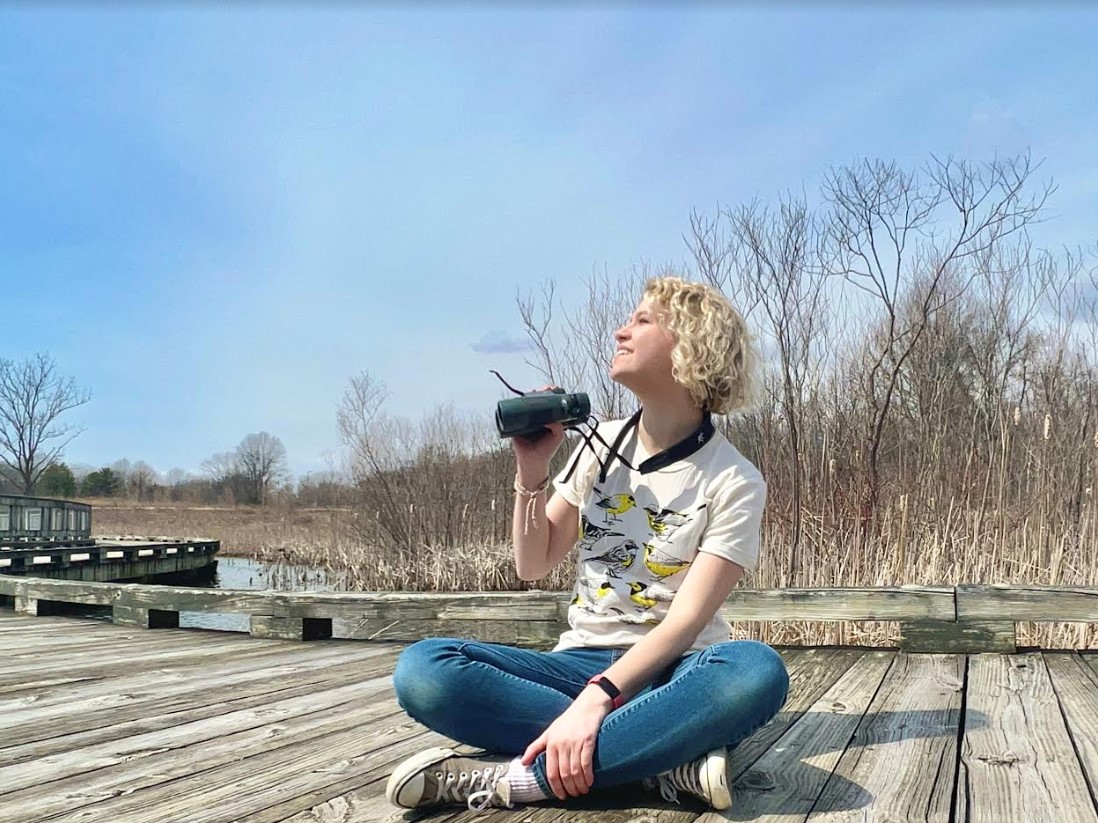The Home-birdy:Planning Your Big Day
By Olivia Bautch
We just passed the first day of spring, and while many species of migrants and summer breeders have already started showing up in the Midwest, the excitement is building. Renowned festivals at Indiana Dunes and Magee Marsh are releasing lineups for May. In the Indianapolis area, teams of birders are preparing for the ABAS Birdathon, a big day competition that begins this month.
It is common for those who consider themselves to be birders to travel hours away to State Natural Areas and Federal Wildlife Refuges for rare birds and greater biodiversity, sometimes spending days at their location. Especially during a big day when individuals or teams attempt to see as many species as they can in twenty-four hours, these trips can be intense, requiring early mornings and hours of nonstop birding in remote, sometimes inaccessible locations. This kind of birding experience isn’t for everyone. Let’s just take a moment to recognize that not all bird-enthusiasts have the time, energy, or physical ability to travel far and spend long hours in the field. I want to give a shout-out to those bird lovers who bird closer to home, as I am one of them. Consider us less of the vagrant type and more of the endemic sort, or ones who might identify as a homebody. That’s why nestled in this title is the endearingly made-up word “home-birdy.” Because we home-birdies are just as much of birders as the rest of them, and we have the chance to see all kinds of good birds too.
For the past six years, I have participated in the Cornell Lab of Ornithology’s Global Big Day, and only one of those years I traveled to a remote refuge. The rest of those years, I traveled between two or three counties and still picked up some really interesting birds. If you’re reading this and consider yourself to be a home-birdy, you can have an eventful big day too!
The Cornell Lab of Ornithology and Madison Audubon give general tips for planning a big day, and I want to elaborate on these, plus add a few tips with local, accessible birding in mind.
#1) Vary Your Route
Basic ecology tells us that in order to maximize biodiversity, you must visit varied habitats. There are many different families of birds, from waders to neotropical migrants to raptors, and you want to make sure you can catch some of each. I try to find species in backyard, urban, wetland, grassland, mudflat, forest, and edge habitats.
You might be surprised where these habitats show up if you live in a metropolitan area. Slightly forested water features attract bugs that warblers are looking for. Reservoirs such as Eagle Creek or Geist bring in waders and gulls. Farm fields and vernal pools like the one at Terry Lee Crossing in Noblesville attract shorebirds and ducks. Edge habitats are great for hawks, orioles, thrushes, and grassland birds.
Something to consider: A few easily accessible habitats include open fields/meadows, wetlands, farm fields, and even industrial park ponds.
#2) Know What’s Where When
It’s good to be organized before the day. I have started typing up plans with where I should be at what time. Using eBird sounds cliche, but the “Change Time Period” feature really helps. You can narrow sightings down to previous big days or even the current month. Write in your plan what bird species you know you will find, and general groups of birds you’ll look for at a specific location. This will let you know if your plan covers every bird family.
Remember that different species of birds are active at different times of the day. Songbirds are most conspicuous in early morning and evening. Gulls, waders, ducks, shorebirds, and raptors will be out all day, so I usually plan those stops in the middle of the day, provided these aren’t heavily recreational locations like beaches and parks.
Something to consider: Write in stops for meals, as well as snacks, medications, or any other rest time you may need.
#3) Pack Well
Depending on what gear you or your team have, you’ll want to have all optics and cameras on hand. Layering up clothes and packing optics is obvious. But you will want to “pack” your favorite apps, guides, maps and your plan for the day as well as lots of water and snacks. If you don’t plan to stop at home over the course of the day, don’t forget appropriate medication, aids, and monitors.
Something to consider: Do you want a buddy? This can increase your bird sightings, but it can also increase your safety if one person gets weak or if you need to swap drivers.
#4) Pace Yourself Always
Some birders can go go go from 5:00 am until 9:00 pm or even through the night. Others need to physically prepare for a big day. Just like any exhausting outing, those with less energy may need to “store up” energy to expend on this day, then rest the day or days after. Cleveland Clinic and others visualize this storing up of energy with the “spoon theory.”
Don’t overdo it. During your big day, you will want to take rest breaks in between birding locations to refresh and regain energy. Remember that a pack can become tiresome after an hour hiking, and that as far out as you hike, you need to hike back. Keep this in mind when deciding how far or how remotely you plan to travel.
Might the noise and activity of public green spaces or beaches be too overwhelming for you? Try to time your location stops with times of the day that see fewer human visitors. Visit beaches and public parks in the morning and evening, with car-birding or rural stops midday. This also increases probable bird activity at the more public locations.
Something to consider: Doctors recommend setting time limits to pace yourself, but this habit can also make sure birders don’t spend too long in one habitat.
#5) Enjoy the Day!
Even the Cornell Lab of Ornithology suggests that a big day can be about more than numbers. It’s important to enjoy and appreciate the birds you are seeing as well as playing the game. Wear birdy graphics and report to eBird. I like to get myself a special coffee or lunch at my favorite restaurant on my big day. After all, this is a birder’s holiday!
Something to consider: The Trip Report feature on eBird allows you to create a day summary of all your stops and share a play-by-play with friends.
I hope this gives you the information and confidence to try for your own local big day. But most importantly, I want to validate those short-range-migrant birders that tend more towards their home range. Proper planning and a few local stops can give us a world of birds, even for the home-birdy. After all, birds fly even if we don’t.
References:
https://madisonaudubon.org/blog/2021/1/3/a-beginners-guide-to-big-day-birding
https://www.allaboutbirds.org/news/a-beginners-guide-to-big-days-handy-tools-for-planning-and-recording/
https://health.clevelandclinic.org/spoon-theory-chronic-illness/

